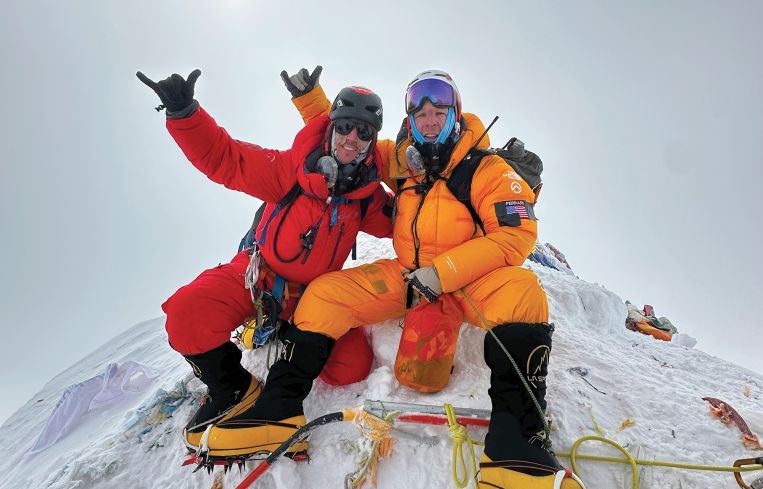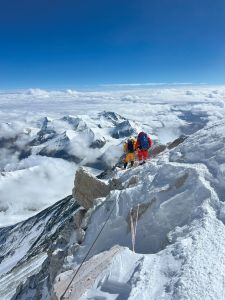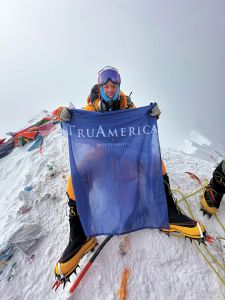Summit! TruAmerica’s Matt Ferrari Just Went to the Very Top of Everest
Ferrari wasn’t satisfied with climbing the mountain's North Col a year ago, and returned to summit in May
By Cathy Cunningham August 5, 2025 11:00 am
reprints
There’s plenty of challenges to surmount in commercial real estate, but few — actually, hopefully, none — involve crampons or ice axes.
For Matt Ferrari, co-chief investment officer and head of East Coast acquisitions at investment firm TruAmerica Multifamily, his “personal Everest” was the mountain itself.
He climbed the mountain’s North Col last year, and this year went to the very top, placing TruAmerica’s flag at its highest point (in a temporary yet unique product placement that few will ever be able to compete with).
After spending 36 days with the Alpenglow Expedition team, Ferrari — along with 11 Sherpas, six guides and four other climbers in his group — reached the peak’s 29,032-foot summit, the highest point on Earth above sea level, via the North, or Tibet, side of the mountain.
The successful climb represented a lifelong goal for Ferrari. He said he approached the process of summiting with the same commitment, enthusiasm and preparation that he brings to his role at TruAmerica in Miami, where he’s worked since 2016. His boss, Robert “Bob” Hart, has supported him every step of the way in both journeys.
“Never once did Bob ask me about work,” Ferrari said of his time on Everest. “He only wanted to talk about the climb. I brought up work at the very end of our conversation after my flight home, and he said, ‘Oh, don’t even worry about that.’ People just want to hear about it, and it’s taken up a lot of time since I got back to work because every conversation includes 15 minutes of questions about Everest, so I have to plan for more time in meetings.”
Top of the world
Ferrari summited Everest at 6:51 a.m. on May 27.
“Every day, you picture it in your mind, and then it’s actually happening,” he said. “Then all of a sudden you’ve been up there for 20 minutes and it’s time to go — and going down is actually way more challenging than going up, because you don’t have as much protection with the ropes as you do going up. And, if you fall going down, you will continue to fall until your carabiners hit the next rope — so, 50 feet.”
In addition to the elation he felt that day, the final part of the ascent also included plenty of humbling moments.
“We got to Mushroom Rock [at 28,047 feet] and our expedition leader said ‘Don’t be alarmed, but there’s a body here,’ ” Ferrari recalled. In total, his group would pass three climbers’ bodies that remained behind on the mountain. (Which is not an unusual thing to see when climbing Everest.)
“Things were going very smoothly on that particular day, but for me it was a snap back to reality and a reminder not to mess up, and not to fall. It kept me measured,” Ferrari said.
Still, roughly two years of intensive training and preparation had brought him to that point, and minimized his chance of failing, from a physical strength perspective at least.
Ferrari worked with Martin Zohr, the same Chamonix, France-based professional performance trainer who helped him train for the North Col, to train for the summit. This past fall, Zohr had climbed Nepal’s 26,781-foot Manaslu — the world’s eighth-tallest mountain — in under 12 hours without supplemental oxygen, the third-fastest time in history. So, Ferrari was in pretty good hands.
He’d trained with Zohr for three months prior to climbing to Everest’s North Col, the 23,031-foot ridge that connects the peak to Changtse in Tibet. But Zohr had a full year to prepare Ferrari for the climb of his life. Ferrari got to work, undertaking intense training blocks interspersed with climbing expeditions.
In August 2024, Ferrari traveled to Chamonix with his girlfriend, Katya, with an intention to climb Mont Blanc, but weather conditions weren’t good and some climbers had died on the mountain as a result. So Ferrari skipped it and focused on ridge and glacier climbing instead. The couple then went to Ecuador for Thanksgiving and Ferrari climbed Antisana, the fourth-tallest volcano in that country at 18,875 feet. A week before he left for Everest, Ferrari returned again to Ecuador and climbed Chimborazo, the tallest mountain there. Then he flew home for a week before flying to Tibet.
Back in Miami, Ferrari worked with strength coach Lavinia Cristache of Anatomy at the 1 Hotel in South Beach, focusing on VO2 max — or aerobic capacity — along with weighted stairmaster training. If you saw a guy on Key Biscayne bridge running sprints, there’s a good chance it was him. The muscle endurance and strength training phase included six-hour weighted sessions on the stairmaster on weekends, and there was no skipping workouts, or sleeping in. If Ferrari had a 7:30 a.m. flight to travel somewhere for work, he’d be in the gym by 4:30 in the morning to work out.
For two months, he slept in a hypoxic tent, which simulates the low-oxygen conditions found on high peaks. “The higher you go, the worse sleep you get, and, if you’re not getting good sleep, you can’t recover from a hard workout,” Ferrari said. “What my trainer made me do as the trip got closer was taper my workouts because I was sleeping at a higher ‘altitude’ [in the hypoxic tent]. If I hadn’t had a coach, I wouldn’t have been willing to do that, because I would have said, ‘I need to be working out more,’ but it allowed me to to reduce the intensity and the volume without feeling guilty, which allowed me to show up to Tibet feeling strong.”

The game-changer
And he’d certainly need that strength.
Like many climbers, Ferrari’s group acclimatized to Everest’s altitude by sleeping at Camp One’s 23,000-foot location without oxygen, before descending and then returning to Camp One for the summit push with oxygen.
“The first time I got to Camp One was one of my lowest points,” Ferrari said. “I was exhausted and couldn’t wait to sleep. It was cold and hard to breathe. I was like ‘I can’t believe I’ve got to sleep here for 12 hours.’ ”
He woke up during the night and asked his tentmate what time it was. “He said it was 1 a.m., and I couldn’t believe I had five or six more hours there,” Ferrari said “I was laying there thinking, ‘This is miserable. What was I thinking, signing up for this?!’ ”
But when that night was over, Ferrari realized one of the hardest parts of the climb was now behind him, because next time he saw Camp One, he’d have supplemental oxygen. The second time, with oxygen, he slept 10.5 hours at Camp One — the first deep sleep since he’d arrived in Tibet.
“I was like, ‘All right, I’ve got this.’ At Camp Two [25,262 feet] with the oxygen on, I also got nine hours and some deep sleep,” Ferrari said. “My two best nights of sleep were at 23,000 feet and 25,000 feet.”
As for what it’s like to sleep on Everest? Unsurprisingly, it’s pretty darn quiet, apart from a Sherpa walking by now and again.
Still, it’s not easy and even at Advanced Base Camp — a mere 21,000 feet — energy conservation is paramount and walking even 20 feet to go to the bathroom is tiring.
“The altitude at that level really kicks your ass,” Ferrari said. “You’ll go to the dinner tent at 4, and take your toothbrush so you don’t have to take back-and-forth trips. And, when I say back and forth, I’m talking 20 feet, but over some gnarly rocks.”
Higher up, it starts to feel like you’re on another planet, Ferrari said. “On the North Col there’s an area that Sherpas probe, because you can walk outside and fall straight through it. Once you get to Camp Two and Three it’s super steep. You’re in the death zone, and you’re just trying to stay in your tent as the wind is gusting.”
Sounds far from relaxing. Yet, even in the death zone, Ferrari felt comfortable enough in his tent to focus on the days ahead rather than the elements outside, and to worry a bit.
“I hate to use this language, but it was a mental mindfuck, just wondering if you’ll succeed,” Ferrari said. “So, ‘Will I summit? Won’t I summit? Will the weather even be good enough for me to summit? Am I going to feel good?’ ”
The elixir qualities of supplemental oxygen made him feel slightly less nervous, but “there’s this constant thing going through your head where you’re asking if you’re getting sick, because some other people on the team got [altitude sickness] and had to leave. I didn’t want to get sick because I didn’t want to leave, but I kept thinking ‘What if that happens to me?’ There’s so much at stake that it becomes a mental struggle as well as a physical struggle.”
As much as supplemental oxygen was the game-changer for Ferrari at Camp One, he also had a small scare with O2 during his climb to Camp Three. The Sherpas had just brought the team new bottles of oxygen, because as a rule they all had to move with a full bottle. Wind was gusting as the team started to move.
“All of a sudden my heart starts racing, and I get really hot,” he said. “My heart rate went from 120 to 150, and I’m like, ‘What the hell just happened to me?’ ”
One guide asked if he was OK.
“Of course!” Ferrari replied, but only because he didn’t want anyone to think something was wrong. The guides checked his oxygen regulator and the flow seemed fine, so Ferrari tried to move again, but he was moving very slowly. “I can’t catch my breath. I’m wobbling all over, and my tentmate was like, ‘What the hell is wrong with you?’ I’m like, ‘I don’t know. It must be the wind?’ A guide said, ‘What the hell are you talking about, dude? It was super windy yesterday, too, and you crushed it,’ ” Ferrari said.
“Holy shit,” he thought. “I can’t breathe.”
“I got hot, my heart was squeezing, and then I just heard Katya’s voice in my head saying, ‘Listen to your body,’ ” he said.
Roberto “Tico” Morales, one of Ferrari’s guides, made him sit down, and they checked his regulator again. This time it said zero, meaning no oxygen flow. “Someone tightens it, and all of a sudden the oxygen starts flowing again and I’m back in action,” he said. “So basically, at 25,500 feet, I had been trying to climb without oxygen.”
The final part of the summit push took five hours, the descent back down along the same traverse 12 hours. Only five out of nine clients in his group summited, the others having to leave due to ill health, and one due to a work commitment.
When he reached Everest’s summit, he hugged Tico. “We did it, man,” Ferrari told him. “You made my dream come true.” He hugged his Sherpa “Young” Lhakpa — who made his 15th summit with Ferrari that day — and felt his eyes welling up with tears.
He had his Garmin Inreach, a high-tech satellite communicating device, with him, and texted Katya, all caps: “I LOVE YOU.” Then: “SUMMIT!”

The mountain less traveled
Ferrari arrived back home to balloons and champagne in his office, and a big celebration put on by his TruAmerica colleagues.
“It was so amazing,” Ferrari said.
Of course, once you achieve your goals, no matter how lofty, there’s the inevitable question of what’s next. “I think it’d be fun over time to finish the Seven Summits [the highest peaks on each of the seven continents]. I’d also like to learn more technical climbing, so I can climb Mount Kenya or the Matterhorn,” Ferrari said. “It’s weird because you can have this massive goal for all these years, then you achieve it and there’s sort of this hole in your life. This blogger I follow talks about how there are no ladders, no shortcuts, no outs to get you out of this hole once you achieve your goal. It just takes time. That really resonated with me.”
There’s also the readjusting back to your work environment, which is difficult enough after a week’s vacation on a Caribbean island, let alone 36 death-defying days on Everest.
“I had these moments,” Ferrari said, “where I was like ‘Man, I was standing on the summit of Everest a week ago, and now I’m back in an office’ — which is also great, but it’s still pretty wild to think about what I just did.”
Cathy Cunningham can be ccunningham@commercialobserver.com.


